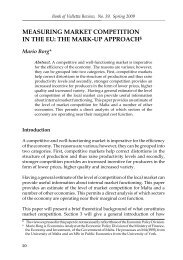Market Gaps on Access to Finance - Bank of Valletta
Market Gaps on Access to Finance - Bank of Valletta
Market Gaps on Access to Finance - Bank of Valletta
Create successful ePaper yourself
Turn your PDF publications into a flip-book with our unique Google optimized e-Paper software.
Table 9: Mapping <strong>of</strong> financial instruments with local agri-food processing firms<br />
Ec<strong>on</strong>omic sec<strong>to</strong>rs Current financing needs Current financing opti<strong>on</strong>s Scope for financial instruments<br />
Agri-food<br />
processing firms<br />
Local agri-food processing firms have a limited<br />
ability <strong>to</strong> exploit ec<strong>on</strong>omies <strong>of</strong> scale compared <strong>to</strong><br />
larger firms in other countries. They also find it<br />
difficult <strong>to</strong> fully utilise technology because <strong>of</strong> their<br />
small producti<strong>on</strong> runs. As a result, Maltese<br />
agriculture cannot compete <strong>on</strong> the basis <strong>of</strong> the<br />
quantity <strong>of</strong> the produce that it produces, but needs<br />
<strong>to</strong> establish specialty niche markets for a<br />
number <strong>of</strong> products <strong>to</strong> ensure sustainability.<br />
This shift in focus requires a sec<strong>to</strong>ral adapti<strong>on</strong> –<br />
this requires investment in new/ upgraded<br />
equipment, process improvement <strong>to</strong> raise quality<br />
standards, and marketing <strong>of</strong> high quality, premium<br />
products that promote the distinctive Maltese<br />
nature <strong>of</strong> the produce being sold.<br />
External threats represented by import<br />
substituti<strong>on</strong> and regulati<strong>on</strong><br />
Need <strong>to</strong> invest in capital<br />
Government policy <strong>to</strong> sustain the industry<br />
Industry focus shifting <strong>to</strong>wards niche products<br />
which do not require mass producti<strong>on</strong><br />
There are significant limitati<strong>on</strong>s in accessing funds<br />
compared <strong>to</strong> larger counterpart firms. This is<br />
reflected in the low capital investment, limited<br />
R&D expenditures and the use <strong>of</strong> internal sources<br />
<strong>of</strong> finance (pers<strong>on</strong>al savings and retained<br />
earnings).<br />
The sec<strong>to</strong>r is again highly dependent <strong>on</strong> lines <strong>of</strong><br />
credit, trade credit as well as grants through<br />
nati<strong>on</strong>al and EU schemes. These include EARDF<br />
schemes such as Measure 124: Cooperati<strong>on</strong> for<br />
development <strong>of</strong> new products, processes and<br />
technologies in the agriculture and food sec<strong>to</strong>r,<br />
and Measure 121: Modernisati<strong>on</strong> <strong>of</strong> agricultural<br />
holdings.<br />
Lower access <strong>to</strong> bank financing<br />
Various nati<strong>on</strong>al/ EU earmarked schemes,<br />
generally based <strong>on</strong> grants<br />
Significant grant dependence<br />
Adequate take-up for nati<strong>on</strong>al grants<br />
Page | 69<br />
The dependence <strong>on</strong> grant assistance is likely <strong>to</strong><br />
remain given the various obstacles inherent in this<br />
sec<strong>to</strong>r and its importance <strong>to</strong> the local envir<strong>on</strong>ment<br />
(bey<strong>on</strong>d the c<strong>on</strong>tributi<strong>on</strong> captured by GDP<br />
figures). In additi<strong>on</strong>, public sec<strong>to</strong>r support can<br />
have an important role <strong>to</strong> play in fostering an<br />
outlook for innovati<strong>on</strong> and in stimulating R&D<br />
cooperati<strong>on</strong>, especially in relati<strong>on</strong> <strong>to</strong> the<br />
exploitati<strong>on</strong> <strong>of</strong> niche markets.<br />
EU funded schemes which would c<strong>on</strong>sider a hybrid<br />
approach between grants and loan guarantees are<br />
likely <strong>to</strong> be a further opti<strong>on</strong> <strong>to</strong> be c<strong>on</strong>sidered in<br />
view <strong>of</strong> the current dependence <strong>on</strong> grant<br />
financing, the lower dependence <strong>on</strong> bank funding<br />
and the unlikely possibility <strong>of</strong> equity financing.<br />
The private sec<strong>to</strong>r, due <strong>to</strong> limited resources,<br />
shows little interest in investing its funds in<br />
projects and research which in most cases is<br />
hindered by a severe limitati<strong>on</strong> in the size and<br />
number <strong>of</strong> projects.<br />
A recent additi<strong>on</strong> <strong>to</strong> the local market is a financial<br />
instituti<strong>on</strong> which will lend <strong>to</strong> agricultural and rural<br />
businesses seeking financing for machinery and<br />
equipment. Though it will initially be targeting UK<br />
businesses, the c<strong>on</strong>cept might be extendable<br />
locally.<br />
Reliance <strong>on</strong> grant assistance <strong>to</strong> remain –<br />
limited scope for innovative financial<br />
instruments<br />
R&D financing opti<strong>on</strong>s would require a<br />
collaborative effort between government<br />
and the private sec<strong>to</strong>r<br />
Specialised financial instituti<strong>on</strong>s, such as a<br />
specialised lenders







